The surface of Kingston Harbour was like highly polished, dark blue glass early this morning. Here and there, a motionless figure perched on a tiny canoe, bent over a fishing line. Pelicans pretended to be statues, on posts near the shore.
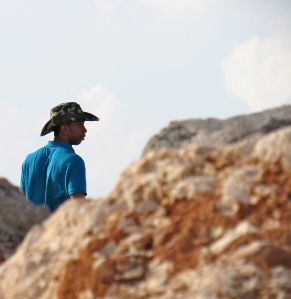
International Beach Cleanup Day rolled around again (it seems to come round so fast) and I was volunteering with Jamaica Environment Trust (JET) at the “End of Stones” location on the Palisadoes spit that runs between the harbor and the open sea. The stones are actually huge boulders, dug out of the hills and piled up along the sea side. The stones are intended to shield the road between the city and the Norman Manley International Airport from storms, high winds and high tides. The stones have yet to be tested by a major storm. I suspect they will simply roll into the road when the next hurricane comes, pushed by wind and waves.
In previous years I have worked at Fort Rocky on the road to Port Royal – where approximately 2,000 volunteers were deployed today. At the End of Stones we had around 1,000 people, in large and small teams. There were family groups – the Chow Family were bright and early; corporate entities such as KPMG; students from the University of Technology and Kingston College; the teachers of May Pen Primary School; service clubs; government agencies such as HEART Trust; Japanese volunteers and civil society groups such as TransWave. To name but a few!
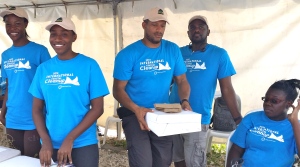
Walking round the End of Stones, where a huge pile of dusty grey sand had created a small mountain, one emerged onto the beach, which stretched down to the tiny white lighthouse on the Port Royal road at the end. The water was silky smooth and unusually calm, stroking smooth black and grey pebbles. The sky simmered in the rising morning heat, and only a faint cool breath came from the sea.
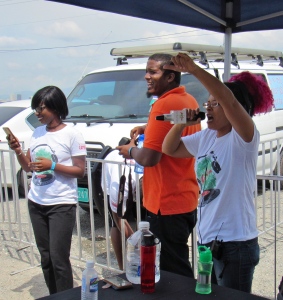
The volunteers stretched down the beach for at least a mile or two, bags trailing. There was plenty to collect – almost all of it washed up on the beach by the sea, much of it from the gullies and rivers, where some Jamaicans are in the habit of dumping their garbage. There were some huge industrial size objects, however, which may have come from a factory, or perhaps even a ship. As usual, plastic bottles were everywhere.
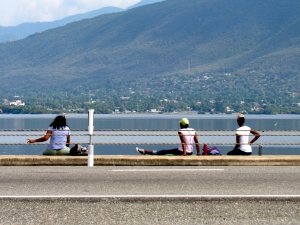
On the harbor side, we gazed at the flat water; the curve of the waterside around by the cement works; the spiky shapes of the ships at anchor; and one moving slowly out with a long, low blast of its horn. Behind lay the green mountains – very green, after all the rain – against a sun-bleached sky.
We had music from Zip FM. The rhythms carried us through the morning, as groups registered with us and asked questions about getting water and collecting their equipment. We managed to hook up stray volunteers with groups, so they could participate. One group – the alumni of the Japan Exchange and Teaching program – were well organized with large igloos containing refreshments, folding chairs and floppy hats. They settled down at the end of our tent, after dutifully collecting garbage, to eat and drink. It got busy, then quieter again. The music started to hypnotize. The hot dog stand smelt good.
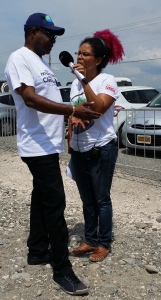
Minister of Tourism Ed Bartlett arrived, and was duly interviewed by the Zip disc jockey, ZJ Sparks (just a few minutes earlier she had been urging on a group of dancers What during a mini dancehall session). The Minister, looking cheerful as usual and wearing the appropriately branded T shirt and cap, was quite knowledgeable about the appalling levels of plastic in the sea. The Tourism Enhancement Fund is the major sponsor of the International Coastal Cleanup Day in Jamaica.
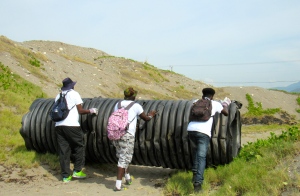
The volunteers were amazing, the atmosphere was friendly – and I believe everyone felt they were making a difference. Special kudos (above all) to Deputy CEO of JET Suzanne Stanley and the fabulous JET team; the Jamaica Constabulary Force, who kept traffic flowing; the St. John Ambulance, who had only two cases to deal with (one nasty cut on a hand, one case of dizziness and mild heatstroke); providers of water, ice and food; and Zip, providers of awesome rhythms. And to all those who turned out on a hot Saturday morning to help clean our beaches.
What more is there to say? Well, in the immortal words of JET’s campaign: Nuh Dutty Up Jamaica! It is far too beautiful. Far too beautiful.
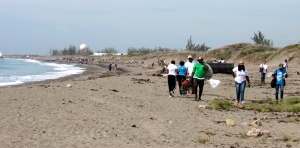
P.S. Something I really enjoy about the Jamaican beach clean up days is that our young people, who might otherwise still be lazing in bed (Friday night is a big night out in Kingston), always join in substantial numbers, every year, with the same enthusiasm. Today, as usual, they put their hearts into the cleanup work, laughing, joking, singing, working together in teams…and they still had a little energy in reserve for a mini dancehall session, before piling into their buses to go back into town. I don’t like to hear people denigrating our youth. I believe (I know) they are trying to do their best in an unforgiving world that has little time for them.
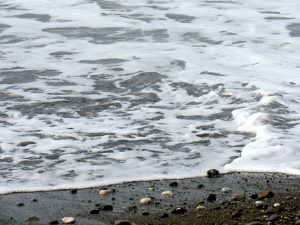
Dear Emma,
International Coastal Clean Up Day! Another great thing we share. In 2004, I organized a tiny clean up at Target Rock Beach, a National Fish & Wildlife Refuge not far from my home. Eventually the Department of the Interior (which governs National Fish & Wildlife Refuges), joined us and after ten years, effectively took it over. They not only clean up the marine pollution at the Refuge but have reduced the amount of trash by education, including multilingual signage for the beachfront fishermen.
Attached is from an early effort. Can you find me? The little boy in the image is my older son, now 16.
Love,
Rachel Frankel, AIA
Rachel Frankel Architecture
10 Park Avenue
New York, NY 10016
tel 212 683-1067
fax 212 683-6150
rf@rachelfrankelarch.com
LikeLike
Hi Rachel, that’s wonderful and glad to hear that you started something near your home that has now developed. I am not seeing the attachment though? Warmest, Emma
LikeLike
Some great photos Emma! Beautiful featured photo.
Twas good to see you too, always doing good work for the environment in Jamaica. Keep it up!
LikeLike
Thanks so much, Kirk! Glad you liked the pics… Hope to see you again soon – somewhere, somehow! (Don’t work too hard…)
LikeLike
I used to organise beach clean-ups as part of Northern Jamaica Conservation Association’s commitment to environmental conservation, but stopped doing so from 2000. Why? Because unless and until our government puts in place a realistic buy-back scheme for recyclables, and bans common non-recyclable packaging such as Styrofoam, the already vast quantities of garbage dumped and littered all around Jamaica will only grow along with our population. Until plastic bottles (for example) have a refund value, they will not be diverted from the waste stream. That is the reality, no matter how much we talk about education and set up drop-off depots. The annual Coastal Clean-up has become a social, media and marketing event supported by some of the very same companies that contribute to the problem (and do not pay the true environmental costs). All this effort and funding should be directed at the root of the problem, not just the symptoms!
LikeLike
Wendy, I see your point but don’t see that as a reason to stop doing cleanups, honestly? Of course yes – it would be grand to have buy-back schemes, but the market doesn’t allow for that just yet, there’s not enough value in it. Nevertheless, recycling companies are doing what they can (not only the Wisynco group, there are others). I see absolutely nothing wrong with marketing and media. That is the way to get the word out. Surely it is better than companies keeping quiet and doing nothing? They should be encouraged to do much more, of course, but let them use their marketing people to advertise it. There are so many other intangible benefits to the cleanups, too. We had mostly young people, some of them very young, many for the first time going out and seeing for themselves how bad the problem is. So the activity is an environmental education in itself. It also really encourages volunteerism, which personally I firmly believe in. And politicians came out and did hands-on work (for the camera, yes) – and they have influence, whether one likes it or not. And Wendy, can’t we tackle the root AND the symptoms at the same time?
LikeLike
Yes, of course we should be able to tackle both, but for now it seems to be all symptoms and no root. I disagree that the recycling companies are doing all they can: beverage producers and distributors can support a deposit-refund system for plastic beverage bottles, Wisynco could stop producing Styrofoam (is it going to build back the factory that burnt down?), and think of it: they are marketing largely unhealthy sugary drinks to people, especially children and young people. Health AND the environment are being affected, but “business” must go on.
I neglected to compliment you on your writing – excellent, as usual!
LikeLike
Problem is the economics of recycling I think, Wendy? Until we can get that right (value of plastics is quite low) private sector will not be fully on board. I agree about Wisynco – they need to rethink and for a start, find an alternative to styrofoam. Oh – thanks for the compliment! 😉
LikeLike
Love this ❤ http://www.misskymmiee.com
LikeLike
Thank you! 🙂
LikeLiked by 1 person